light TOYOTA C-HR 2020 Warranties & Maintenance Guides (in English)
[x] Cancel search | Manufacturer: TOYOTA, Model Year: 2020, Model line: C-HR, Model: TOYOTA C-HR 2020Pages: 260, PDF Size: 8.54 MB
Page 184 of 260
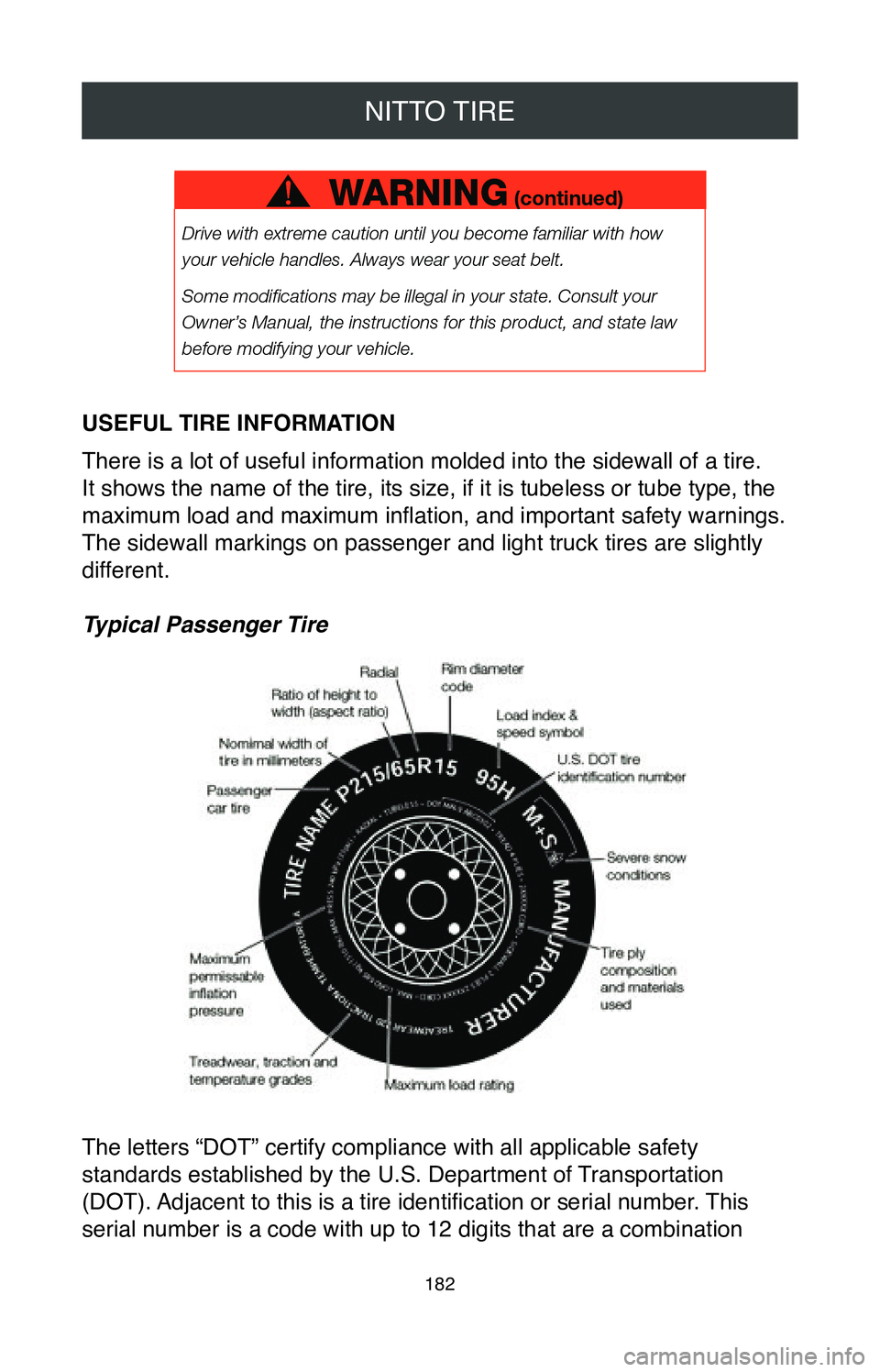
NITTO TIRE
182
USEFUL TIRE INFORMATION
There is a lot of useful information molded into the sidewall of a tire.\
It shows the name of the tire, its size, if it is tubeless or tube type,\
the
maximum load and maximum inflation, and important safety warnings.
The sidewall markings on passenger and light truck tires are slightly
different.
Typical Passenger Tire
The letters “DOT” certify compliance with all applicable safety
standards established by the U.S. Department of Transportation
(DOT). Adjacent to this is a tire identification or serial number. This
serial number is a code with up to 12 digits that are a combination
Page 185 of 260
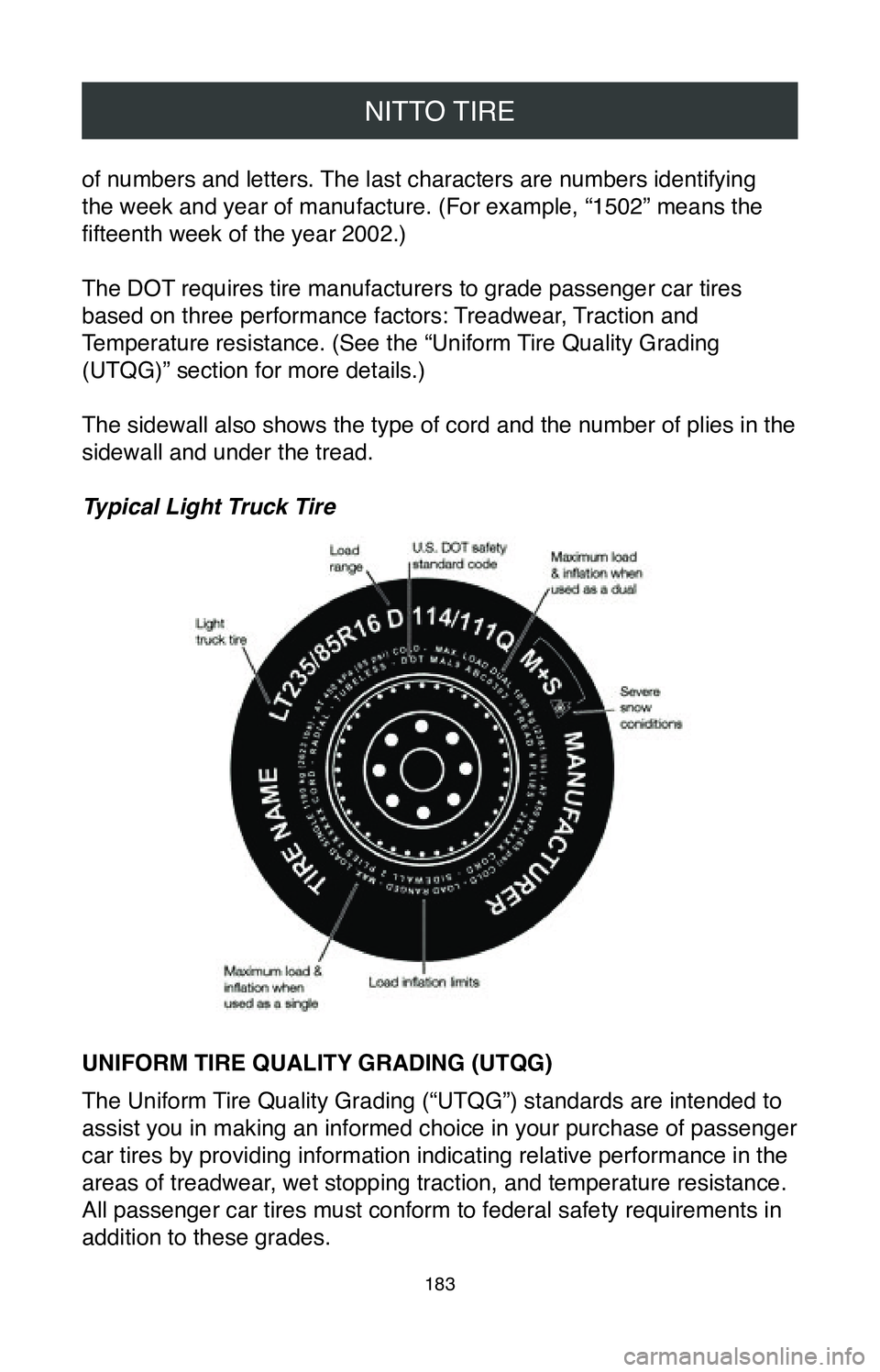
NITTO TIRE
183
of numbers and letters. The last characters are numbers identifying
the week and year of manufacture. (For example, “1502” means the
fifteenth week of the year 2002.)
The DOT requires tire manufacturers to grade passenger car tires
based on three performance factors: Treadwear, Traction and
Temperature resistance. (See the “Uniform Tire Quality Grading
(UTQG)” section for more details.)
The sidewall also shows the type of cord and the number of plies in the \
sidewall and under the tread.
Typical Light Truck Tire
UNIFORM TIRE QUALITY GRADING (UTQG)
The Uniform Tire Quality Grading (“UTQG”) standards are intended to
assist you in making an informed choice in your purchase of passenger
car tires by providing information indicating relative performance in th\
e
areas of treadwear, wet stopping traction, and temperature resistance.
All passenger car tires must conform to federal safety requirements in
addition to these grades.
Page 189 of 260
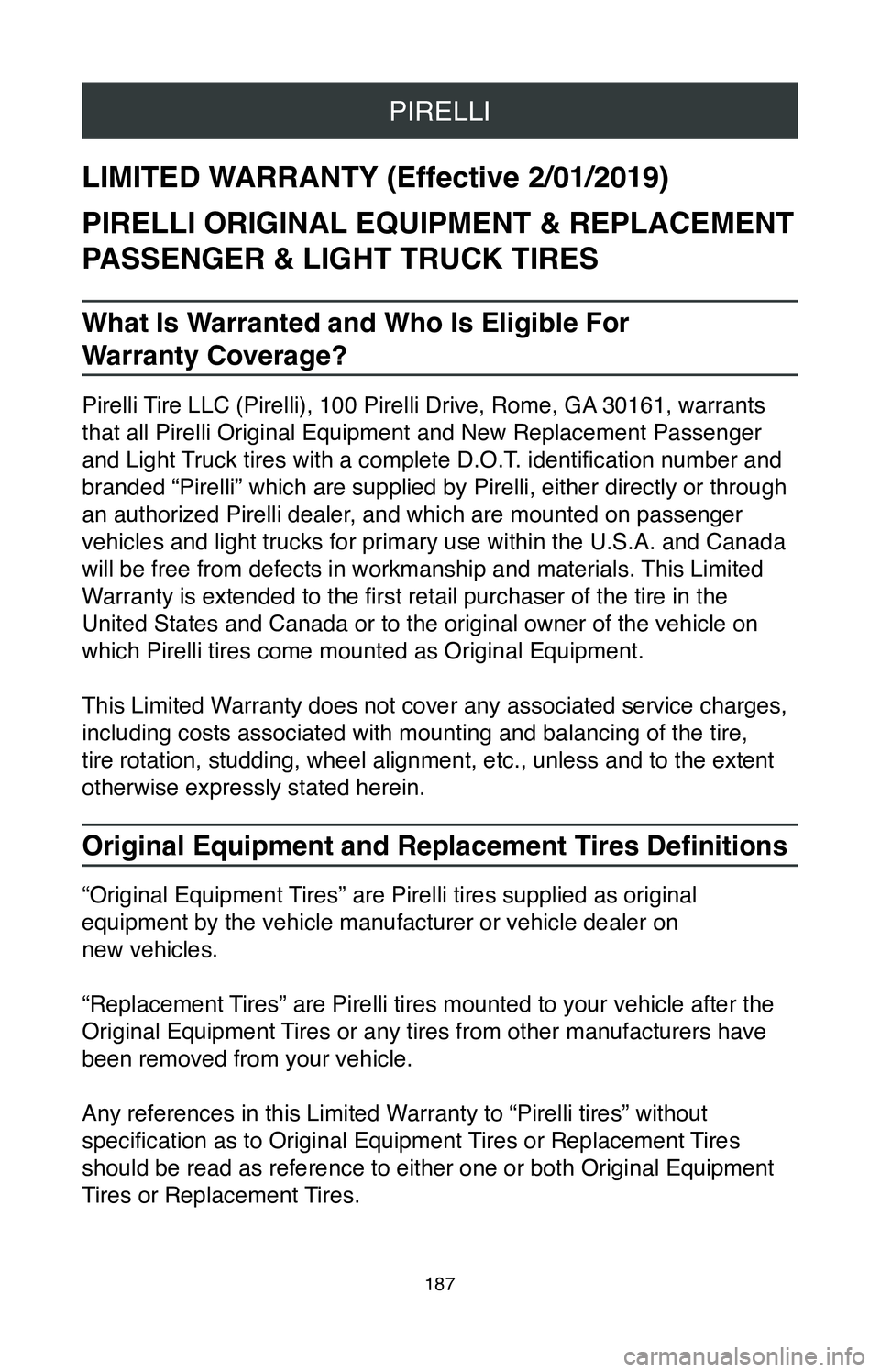
PIRELLI
187
LIMITED WARRANTY (Effective 2/01/2019)
PIRELLI ORIGINAL EQUIPMENT & REPLACEMENT
PASSENGER & LIGHT TRUCK TIRES
What Is Warranted and Who Is Eligible For
Warranty Coverage?
Pirelli Tire LLC (Pirelli), 100 Pirelli Drive, Rome, GA 30161, warrants
that all Pirelli Original Equipment and New Replacement Passenger
and Light Truck tires with a complete D.O.T. identification number and
branded “Pirelli” which are supplied by Pirelli, either directly o\
r through
an authorized Pirelli dealer, and which are mounted on passenger
vehicles and light trucks for primary use within the U.S.A. and Canada
will be free from defects in workmanship and materials. This Limited
Warranty is extended to the first retail purchaser of the tire in the
United States and Canada or to the original owner of the vehicle on
which Pirelli tires come mounted as Original Equipment.
This Limited Warranty does not cover any associated service charges,
including costs associated with mounting and balancing of the tire,
tire rotation, studding, wheel alignment, etc., unless and to the extent\
otherwise expressly stated herein.
Original Equipment and Replacement Tires Definitions
“Original Equipment Tires” are Pirelli tires supplied as original
equipment by the vehicle manufacturer or vehicle dealer on
new vehicles.
“Replacement Tires” are Pirelli tires mounted to your vehicle after the
Original Equipment Tires or any tires from other manufacturers have
been removed from your vehicle.
Any references in this Limited Warranty to “Pirelli tires” without
specification as to Original Equipment Tires or Replacement Tires
should be read as reference to either one or both Original Equipment
Tires or Replacement Tires.
Page 192 of 260
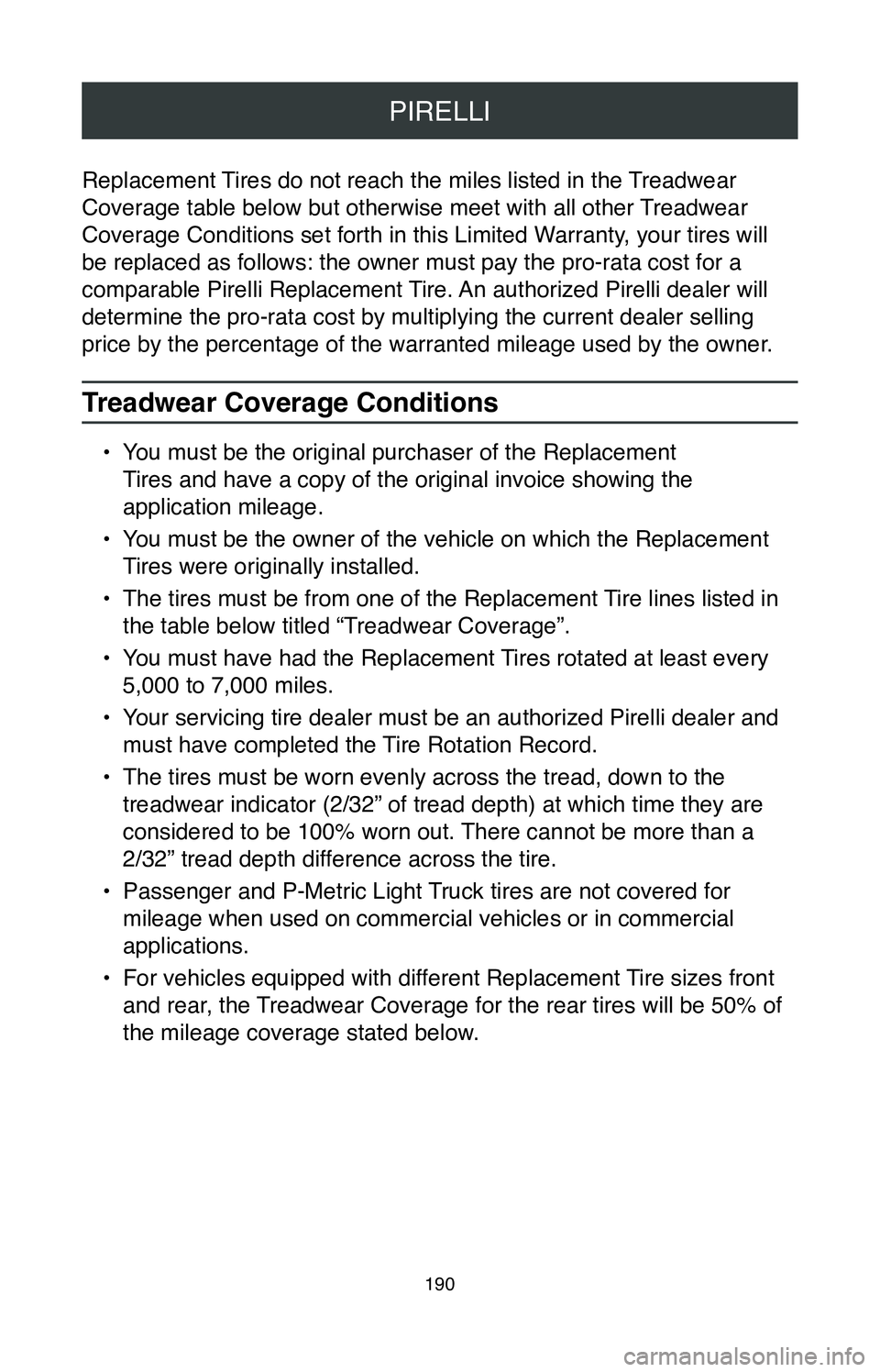
PIRELLI
190
Replacement Tires do not reach the miles listed in the Treadwear
Coverage table below but otherwise meet with all other Treadwear
Coverage Conditions set forth in this Limited Warranty, your tires will
be replaced as follows: the owner must pay the pro-rata cost for a
comparable Pirelli Replacement Tire. An authorized Pirelli dealer will
determine the pro-rata cost by multiplying the current dealer selling
price by the percentage of the warranted mileage used by the owner.
Treadwear Coverage Conditions
• You must be the original purchaser of the Replacement
Tires and have a copy of the original invoice showing the
application mileage.
•
You must be the owner of the vehicle on which the Replacement
Tires were originally installed.
•
The tires must be from one of the Replacement Tire lines listed in
the table below titled “Treadwear Coverage”.
•
You must have had the Replacement Tires rotated at least every
5,000 to 7,000 miles.
•
Your servicing tire dealer must be an authorized Pirelli dealer and
must have completed the Tire Rotation Record.
•
The tires must be worn evenly across the tread, down to the
treadwear indicator (2/32” of tread depth) at which time they are
considered to be 100% worn out. There cannot be more than a
2/32” tread depth difference across the tire.
•
Passenger and P-Metric Light Truck tires are not covered for
mileage when used on commercial vehicles or in commercial
applications.
•
For vehicles equipped with different Replacement Tire sizes front
and rear, the Treadwear Coverage for the rear tires will be 50% of
the mileage coverage stated below.
Page 199 of 260
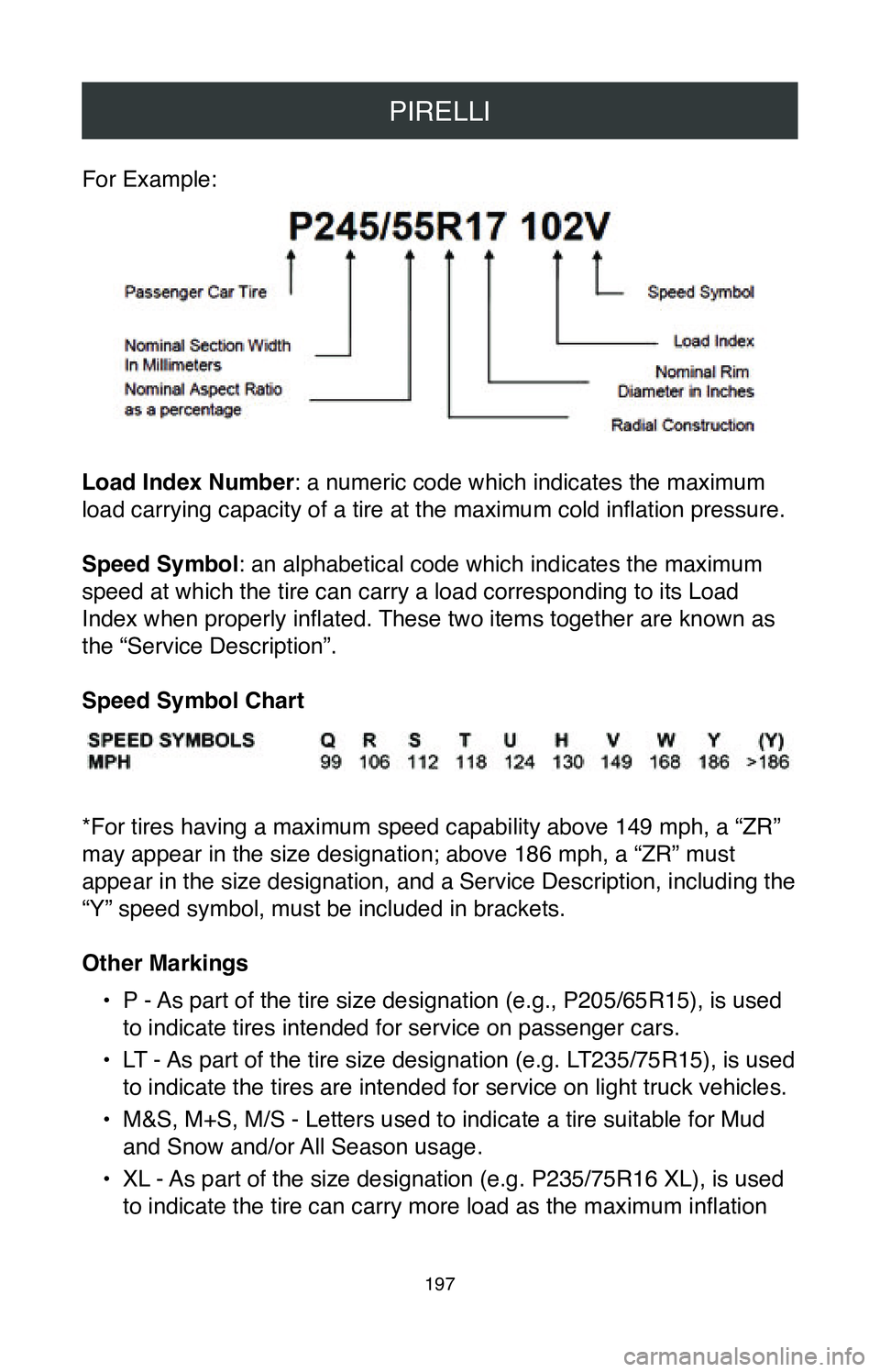
PIRELLI
197
For Example:
Load Index Number: a numeric code which indicates the maximum
load carrying capacity of a tire at the maximum cold inflation pressure.
Speed Symbol: an alphabetical code which indicates the maximum
speed at which the tire can carry a load corresponding to its Load
Index when properly inflated. These two items together are known as
the “Service Description”.
Speed Symbol Chart
*For tires having a maximum speed capability above 149 mph, a “ZR”
may appear in the size designation; above 186 mph, a “ZR” must
appear in the size designation, and a Service Description, including the\
“Y” speed symbol, must be included in brackets.
Other Markings
•
P - As part of the tire size designation (e.g., P205/65R15), is used
to indicate tires intended for service on passenger cars.
•
LT - As part of the tire size designation (e.g. LT235/75R15), is used
to indicate the tires are intended for service on light truck vehicles.
•
M&S, M+S, M/S - Letters used to indicate a tire suitable for Mud
and Snow and/or All Season usage.
•
XL - As part of the size designation (e.g. P235/75R16 XL), is used
to indicate the tire can carry more load as the maximum inflation
Page 204 of 260
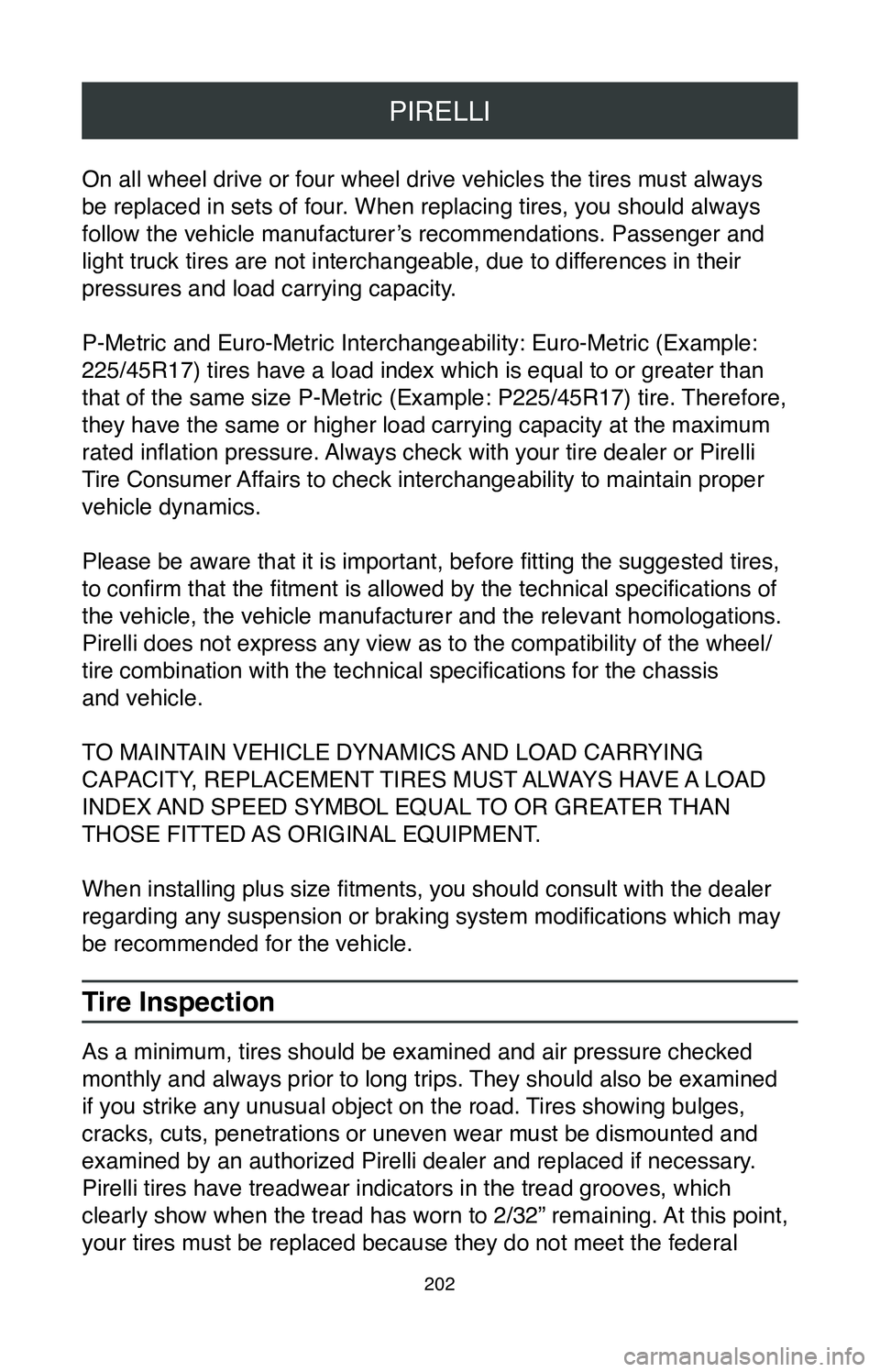
PIRELLI
202
On all wheel drive or four wheel drive vehicles the tires must always
be replaced in sets of four. When replacing tires, you should always
follow the vehicle manufacturer’s recommendations. Passenger and
light truck tires are not interchangeable, due to differences in their
pressures and load carrying capacity.
P-Metric and Euro-Metric Interchangeability: Euro-Metric (Example:
225/45R17) tires have a load index which is equal to or greater than
that of the same size P-Metric (Example: P225/45R17) tire. Therefore,
they have the same or higher load carrying capacity at the maximum
rated inflation pressure. Always check with your tire dealer or Pirelli
Tire Consumer Affairs to check interchangeability to maintain proper
vehicle dynamics.
Please be aware that it is important, before fitting the suggested tires,
to confirm that the fitment is allowed by the technical specifications of
the vehicle, the vehicle manufacturer and the relevant homologations.
Pirelli does not express any view as to the compatibility of the wheel/
tire combination with the technical specifications for the chassis
and vehicle.
TO MAINTAIN VEHICLE DYNAMICS AND LOAD CARRYING
CAPACITY, REPLACEMENT TIRES MUST ALWAYS HAVE A LOAD
INDEX AND SPEED SYMBOL EQUAL TO OR GREATER THAN
THOSE FITTED AS ORIGINAL EQUIPMENT.
When installing plus size fitments, you should consult with the dealer
regarding any suspension or braking system modifications which may
be recommended for the vehicle.
Tire Inspection
As a minimum, tires should be examined and air pressure checked
monthly and always prior to long trips. They should also be examined
if you strike any unusual object on the road. Tires showing bulges,
cracks, cuts, penetrations or uneven wear must be dismounted and
examined by an authorized Pirelli dealer and replaced if necessary.
Pirelli tires have treadwear indicators in the tread grooves, which
clearly show when the tread has worn to 2/32” remaining. At this point,
your tires must be replaced because they do not meet the federal
Page 207 of 260
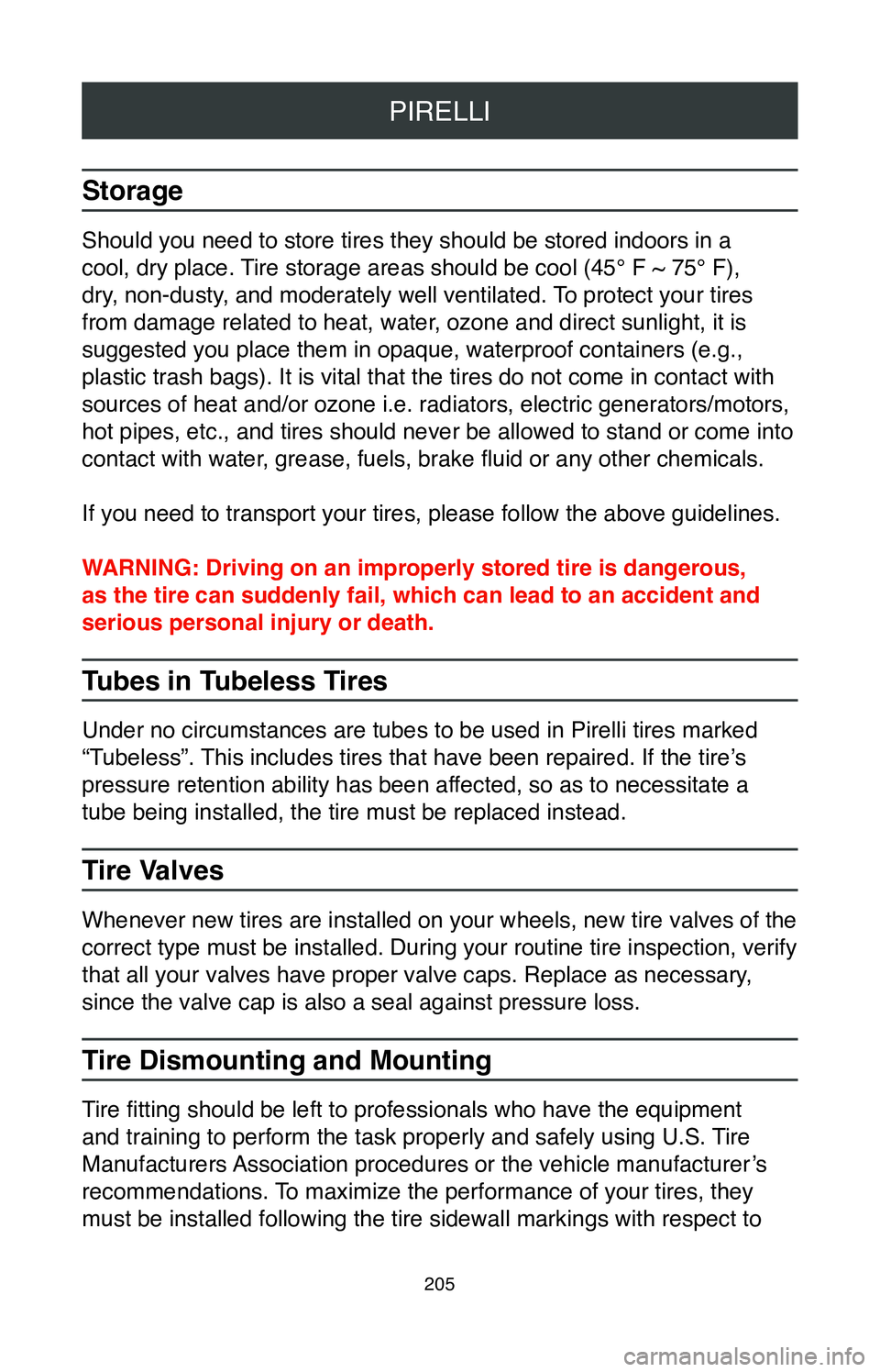
PIRELLI
205
Storage
Should you need to store tires they should be stored indoors in a
cool, dry place. Tire storage areas should be cool (45° F ~ 75° F),
dry, non-dusty, and moderately well ventilated. To protect your tires
from damage related to heat, water, ozone and direct sunlight, it is
suggested you place them in opaque, waterproof containers (e.g.,
plastic trash bags). It is vital that the tires do not come in contact \
with
sources of heat and/or ozone i.e. radiators, electric generators/motors,\
hot pipes, etc., and tires should never be allowed to stand or come into\
contact with water, grease, fuels, brake fluid or any other chemicals.
If you need to transport your tires, please follow the above guidelines.\
WARNING: Driving on an improperly stored tire is dangerous,
as the tire can suddenly fail, which can lead to an accident and
serious personal injury or death.
Tubes in Tubeless Tires
Under no circumstances are tubes to be used in Pirelli tires marked
“Tubeless”. This includes tires that have been repaired. If the tire’s
pressure retention ability has been affected, so as to necessitate a
tube being installed, the tire must be replaced instead.
Tire Valves
Whenever new tires are installed on your wheels, new tire valves of the \
correct type must be installed. During your routine tire inspection, ver\
ify
that all your valves have proper valve caps. Replace as necessary,
since the valve cap is also a seal against pressure loss.
Tire Dismounting and Mounting
Tire fitting should be left to professionals who have the equipment
and training to perform the task properly and safely using U.S. Tire
Manufacturers Association procedures or the vehicle manufacturer’s
recommendations. To maximize the performance of your tires, they
must be installed following the tire sidewall markings with respect to
Page 209 of 260
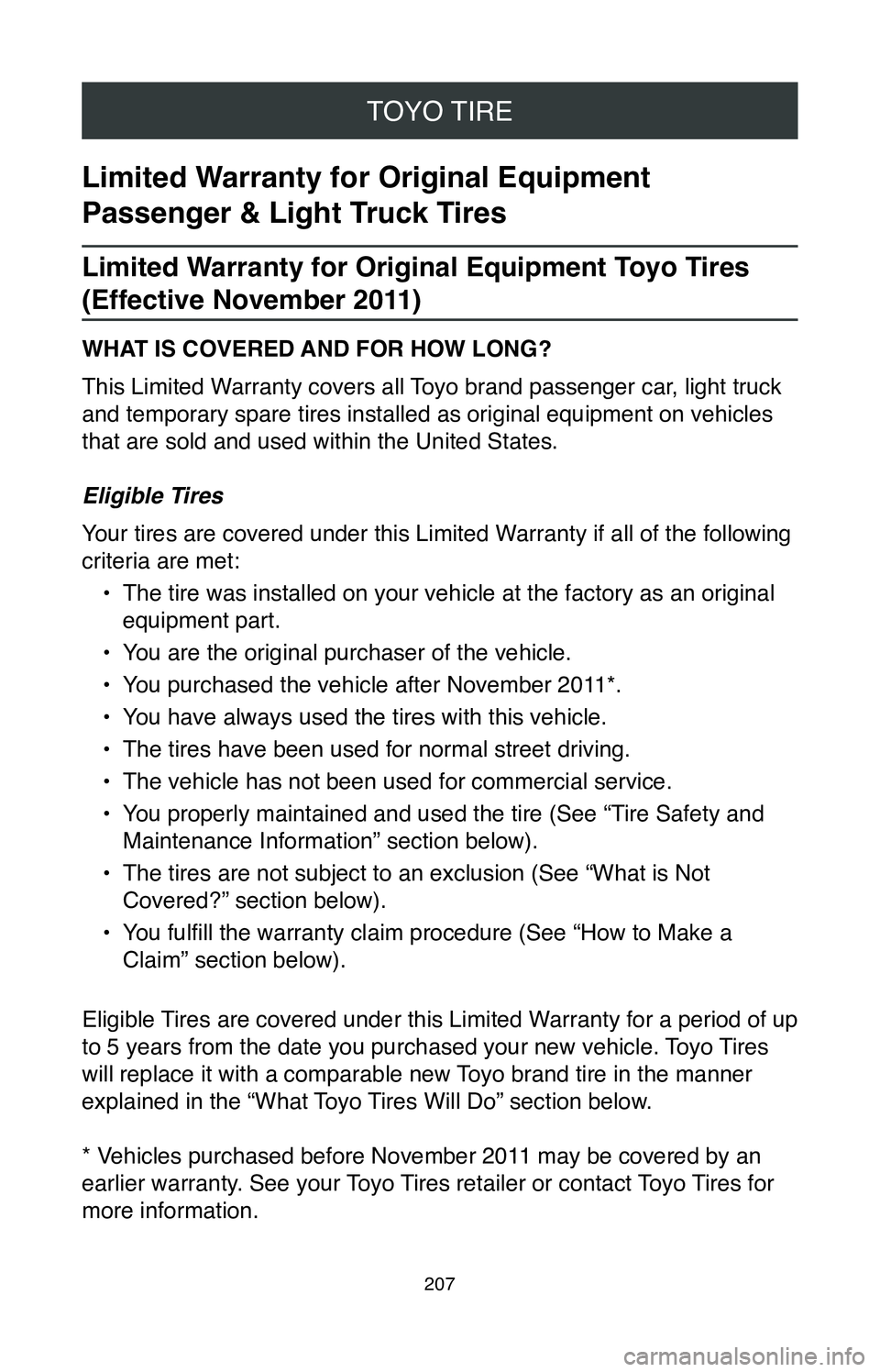
TOYO TIRE
207
Limited Warranty for Original Equipment
Passenger & Light Truck Tires
Limited Warranty for Original Equipment Toyo Tires
(Effective November 2011)
WHAT IS COVERED AND FOR HOW LONG?
This Limited Warranty covers all Toyo brand passenger car, light truck
and temporary spare tires installed as original equipment on vehicles
that are sold and used within the United States.
Eligible Tires
Your tires are covered under this Limited Warranty if all of the following
criteria are met:•
The tire was installed on your vehicle at the factory as an original
equipment part.
•
You are the original purchaser of the vehicle.
•
You purchased the vehicle after November 2011*.
•
You have always used the tires with this vehicle.
•
The tires have been used for normal street driving.
•
The vehicle has not been used for commercial service.
•
You properly maintained and used the tire (See “Tire Safety and
Maintenance Information” section below).
•
The tires are not subject to an exclusion (See “What is Not
Covered?” section below).
•
You fulfill the warranty claim procedure (See “How to Make a
Claim” section below).
Eligible Tires are covered under this Limited Warranty for a period of up
to 5 years from the date you purchased your new vehicle. Toyo Tires
will replace it with a comparable new Toyo brand tire in the manner
explained in the “What Toyo Tires Will Do” section below.
* Vehicles purchased before November 2011 may be covered by an
earlier warranty. See your Toyo Tires retailer or contact Toyo Tires for
more information.
Page 224 of 260
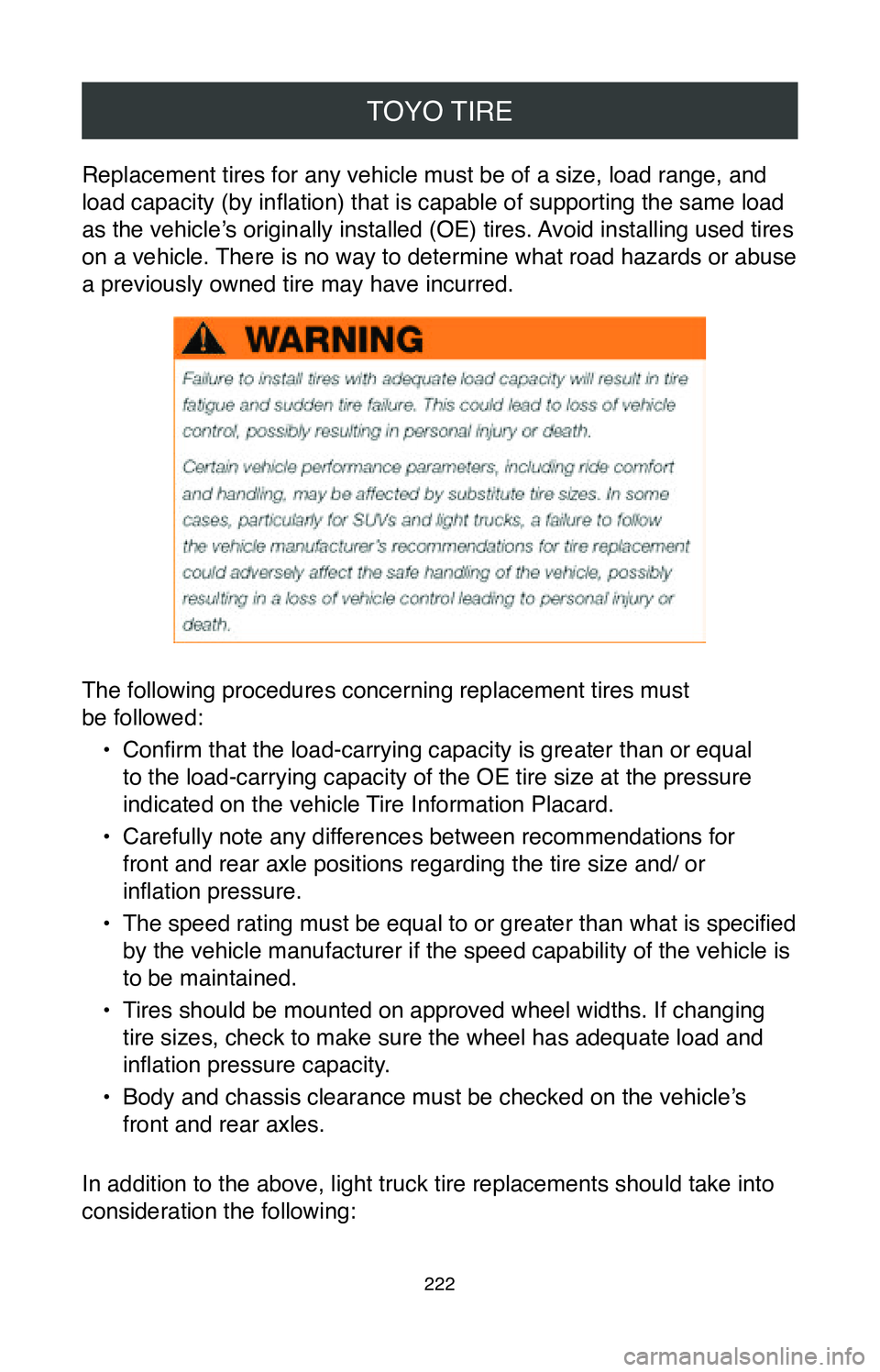
TOYO TIRE
222
Replacement tires for any vehicle must be of a size, load range, and
load capacity (by inflation) that is capable of supporting the same load
as the vehicle’s originally installed (OE) tires. Avoid installing used tires
on a vehicle. There is no way to determine what road hazards or abuse
a previously owned tire may have incurred.
The following procedures concerning replacement tires must
be followed:•
Confirm that the load-carrying capacity is greater than or equal
to the load-carrying capacity of the OE tire size at the pressure
indicated on the vehicle Tire Information Placard.
•
Carefully note any differences between recommendations for
front and rear axle positions regarding the tire size and/ or
inflation pressure.
•
The speed rating must be equal to or greater than what is specified
by the vehicle manufacturer if the speed capability of the vehicle is
to be maintained.
•
Tires should be mounted on approved wheel widths. If changing
tire sizes, check to make sure the wheel has adequate load and
inflation pressure capacity.
•
Body and chassis clearance must be checked on the vehicle’s
front and rear axles.
In addition to the above, light truck tire replacements should take into\
consideration the following:
Page 225 of 260
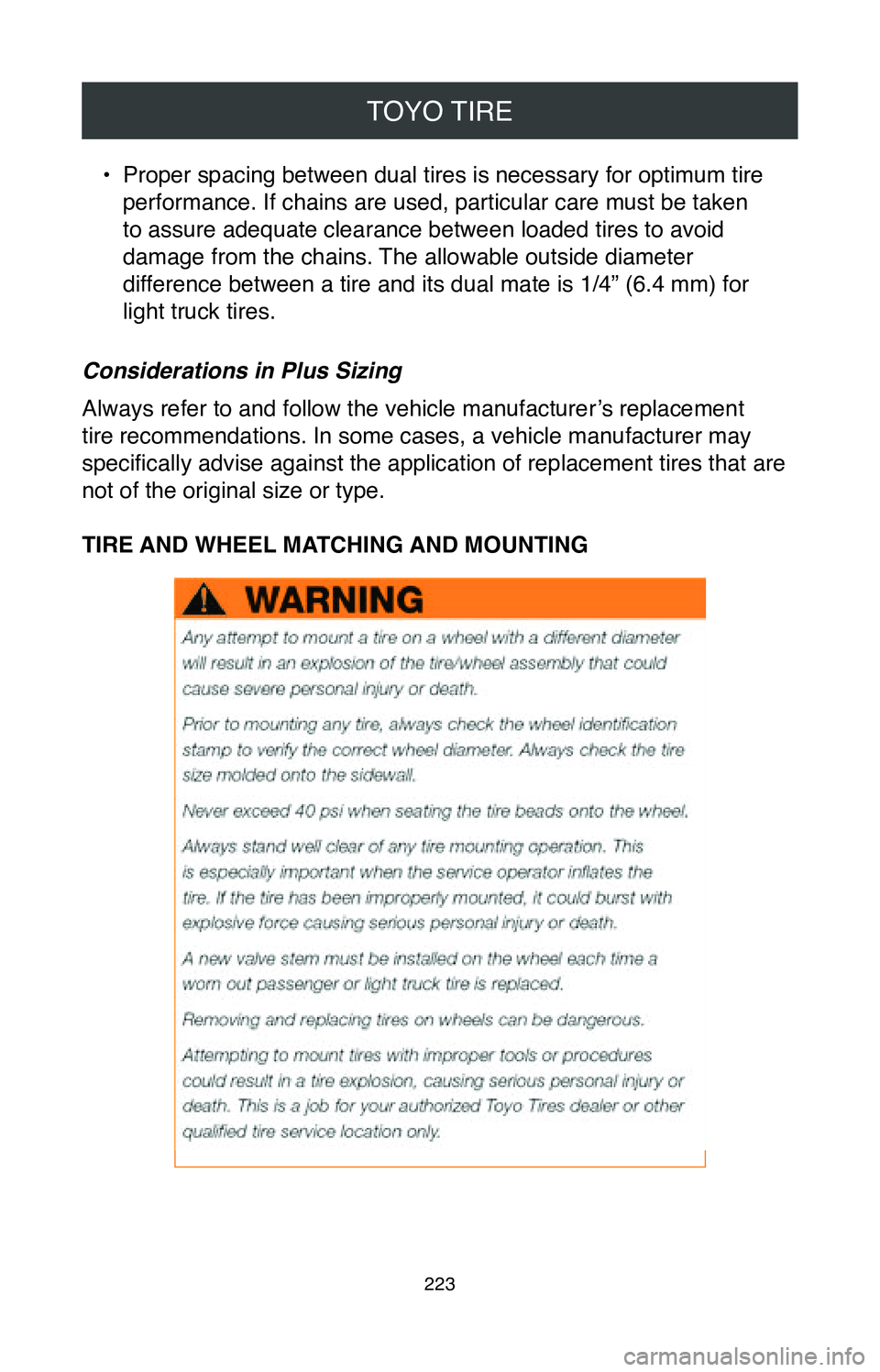
TOYO TIRE
223
• Proper spacing between dual tires is necessary for optimum tire
performance. If chains are used, particular care must be taken
to assure adequate clearance between loaded tires to avoid
damage from the chains. The allowable outside diameter
difference between a tire and its dual mate is 1/4” (6.4 mm) for
light truck tires.
Considerations in Plus Sizing
Always refer to and follow the vehicle manufacturer’s replacement
tire recommendations. In some cases, a vehicle manufacturer may
specifically advise against the application of replacement tires that are
not of the original size or type.
TIRE AND WHEEL MATCHING AND MOUNTING